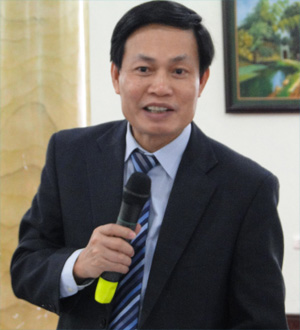

Prof. Dr. Nguyen Huu Duc (Vice Director of Vietnam National University, Hanoi)
Professor, what were the foundations upon which Vietnam National University, Hanoi developed the 1206 criteria for research universities?
First of all, it must be said that, following an advanced university governance approach, Vietnam National University, Hanoi (VNU) pays great attention to internal analysis, goal management, and system management through its indicators. Goals are the direction, while indicators are the positioning. The set of criteria for research universities recently issued by VNU serves as the basis for VNU and its member and affiliated training and research units to analyze, evaluate, and position their current status, determine the correct development plan to prioritize investment, and promote the gradual development of units to meet regional and international research university standards. The set of criteria includes many quantified groups of criteria such as criteria on scientific research achievements and knowledge transfer; criteria on training quality; criteria on the level of internationalization; and criteria on infrastructure serving training and research.
This set of criteria is compiled and specified based on the classification criteria of Carnegie University (USA), the research university ranking criteria of Amano (Japan), the QS university star rating criteria with a target of 4 stars or higher (or/and in the top 500 worldwide), the criteria for defining research universities of the Association of American Universities, while also considering specific factors in the context of Vietnam. These criteria are developed with the goal of ensuring both standardized approaches and international integration, while remaining relevant to the practical development of science and education in Vietnam, and aligning with the current capabilities of Vietnam National University, Hanoi.
Professor, how were the criteria issued, along with the implementation roadmap and objectives for each stage?
Vietnam National University, Hanoi (VNU) has set itself the goal of becoming a multidisciplinary, multi-field research university center meeting international standards, ranking among the top 200 universities in Asia by 2015, and rising to the top 100 universities in the world by 2020. Corresponding to this roadmap, this set of criteria includes very specific indicators for a university in the top 200 in Asia.
To ensure the serious and effective implementation of this roadmap, Vietnam National University, Hanoi (VNU) requires that annually, the heads of member and affiliated training and research units, based on the guidelines, summarize the performance of their tasks for the academic year, analyze the current situation, and self-assess the level of achievement of research university standards for their unit. This is also an important basis for determining the planned targets and solutions for implementing tasks in the following academic year. The results of the assessment of the level of achievement of research university standards according to these guidelines are a mandatory appendix attached to the annual summary report and the unit's annual budget plan.
Compared to these criteria, the University of Science has now made very promising approaches. The Universities of Social Sciences and Humanities and the University of Economics have proactively set annual targets for improving the results of these indicators.
- That's the implementation status of the individual units, but what are the results for the entire Vietnam National University, Hanoi, Professor?
In 2014, Vietnam National University, Hanoi (VNU) continued to achieve encouraging results in university rankings. According to the QS ranking, VNU was ranked among the top 161-170 universities in Asia; and ranked first in Vietnam. In the SCImago research group's ranking of scientific research units (based on data up to 2012), VNU ranked 2327th in the world, second in Vietnam for international publications; ranked 284th in the world for the innovation index; and ranked 346th in the world and first in Vietnam for the size of its online portal. According to the Webometrics ranking by Cybemetrics Lab, VNU's international publications were ranked 1829th in the world, second among Vietnamese universities (based on data up to 2013). VNU's endogenous resources and international publications are ranked 899th in the world, 207th in Asia, and 1st in Vietnam; its digital library (endogenous resource) is ranked 794th in the world, 131st in Asia, and 1st in Vietnam. These figures can be considered well-deserved results for the consistent implementation of goal-oriented governance by VNU.
Professor, could you please explain in more detail the meaning of these rankings?
QS Rankingshttp://www.topuniversities.com/node/4084/ranking-details/asian-university-rankings/2014) has been closely associated with VNU for many years. This is a fairly good mapping with the 1209 criteria for research universities. SCImago ranking (Spain)http://www.scimagoir.comScopus only considers research results and ranks universities and research institutions based on the previous year's publication of over 100 articles in the Scopus database. Vietnam has four institutions included in this ranking: the Vietnam Academy of Science and Technology, the Vietnam National University Ho Chi Minh City, the Vietnam National University Hanoi, and Hanoi University of Science and Technology.
In the presentation above, in addition to ranking the total number of publications, I intentionally included the results of the innovation index assessment in research works. This index is measured by the number of times scientific articles are cited in inventions and patents. Some believe that VNU Hanoi remains primarily a basic research institution, but its world ranking of 284 shows the extent to which our basic research has guided inventions and patents (the Vietnam Academy of Science and Technology and VNU Ho Chi Minh City both have an index of 282).
- One observation is that all the rankings above share common criteria regarding international publications and website size?
That's a correct observation, and it's true to the trend of the times. At its inception (2004), the Webometrics ranking actually (http://www.webometrics.infoThe Webometrics ranking initially focused solely on the scale and influence of university websites, including the size of their digital resources. Later (from 2012), this ranking added the number of international publications by universities in the Scopus database. Therefore, the current Webometrics ranking integrates two current trends in university development: research (international publications) and digitalization (digital resources). Because it integrates both of these indicators, no Vietnamese university, except for Vietnam National University, Hanoi, has managed to enter the top 1000 worldwide. For the Scimago ranking, in addition to digitalization and research results, the impact and contribution of basic research to the creation of inventions and innovations are also assessed.
Professor, what are the solutions to continue developing Vietnam National University, Hanoi towards standardization and international integration?
In today's era, the requirements for rapid and sustainable development share the following five characteristics: (i) openness, knowledge exchange, and exploitation of global needs; (ii) stability and consensus; (iii) correct orientation towards the future, following trends and laws; (iv) focused and efficient investment; (v) allocation of resources according to market mechanisms, based on output; and (v) reputable leadership and a capable administrative apparatus. In this discussion, I will limit myself to three points (i, iii, and iv). Firstly, in recent years, we have actively opened up and integrated deeply, especially with universities within the ASEAN University Network (AUN). During this process, the management of training quality, scientific research, and quality assurance conditions has been transferred concretely and effectively. We have integrated and implemented quality assurance activities in accordance with international practices, standards, and models. Through this, we have become familiar with and confidently implemented several sets of indicators for internal analysis and university governance. This integration process needs to be comprehensively and decisively promoted. Secondly, regarding future orientation, we have implemented good goal management, building a reasonable set of indicators, which are essentially the criteria for research universities that we are pursuing. Without quantifying our activities, we will lose direction in investing to increase value. Scientific governance and the trend of relying on data analysis and indicators are very attractive because they are measurable and can create rapid growth. There may be some rigidity when relying too much on data, but it is still necessary as we are in the early stages of integration. Ultimately, the issue of resource allocation based on output is a method, but in essence, it is the driving force and the ultimate goal. Through this method, everyone strives to ensure that VNU produces better training and scientific and technological products, and that the quality of our staff is measured more accurately.
- Developing a good plan is difficult enough, but successfully implementing it is even more challenging. Professor, what can you say before we conclude this discussion?
I just put together a few meaningful English letters: IT – I&T. When you mention IT, everyone immediately understands it stands for Information Technology. The letter I is close to that meaning: information and knowledge, while the letter T stands for time. I want to explain further: in the age of information technology (IT), the world is flat, society is an information society, and we have a lot of information and knowledge (I). Knowing a lot of I means knowing in advance what the world is doing and motivating and advising leaders to implement it. But knowing isn't enough; we need to choose the right time (T). That's what makes persistence effective. In the past, we've been learning and working to accumulate enough I, enough information about rankings and international publication trends, but we can't just rely on willpower and aggressive implementation. We have worked together to convince each other, build a shared culture, and choose the right time (T) and resources for implementation. Now is the right time (T) for us to synchronously implement the information we have learned and selected during the integration process across all member and affiliated units; to widely and comprehensively apply the goals and criteria we have developed through the environment and approach of information technology. We have followed the right process, and we are confident that we will succeed.
Thank you, Professor.
Author:Mai Anh-Thanh Ha
Newer news
Older news